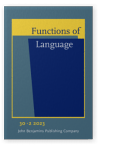Vol. 30:2 (2023) ► pp.159–182
The genre specifics of English wh-exclamatives
This paper puts forward the hypothesis that wh-exclamatives in Present-day English are much more genre-specific than has previously been acknowledged. To test this, prototypical how- and what-exclamatives are searched for in three different corpora containing material from conceptually oral language, that is prose fiction, personal letters and informal, spontaneous face-to-face conversations. The results show that in terms of token frequency, wh-exclamatives are most frequent in personal letters, a genre which has hitherto not been linked with exclamatives. Furthermore, the outcomes demonstrate that each genre shows a different distribution of exclamatives. In all cases, the different structural realizations (clausal vs. non-clausal form) can be connected to the function the exclamative fulfills in the respective genre and to the general properties of the three distinct text types. The results compel us to consider that exclamatives might be more specialized than has been believed so far.
Article outline
- 1.Introduction
- 2.The syntax and semantics of exclamatives
- 2.1The syntactic characteristics of wh-exclamatives
- 2.2Semantic and pragmatic characteristics of wh-exclamatives
- 3.Methodology
- 3.1Parameters of orality
- 3.2Data sources and collection of data
- 4.Results
- 5.Discussion
- 6.Conclusion
- Notes
-
References
